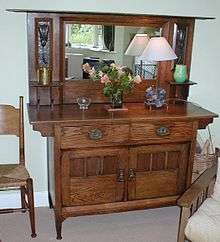Harris Lebus

Harris Lebus was a furniture manufacturer and wholesaler based in the East End of London in Tabernacle Street with a factory in Tottenham. The firm supplied stores such as Maple & Co., mainly producing bedroom and dining cabinets.
History
During the period of its finest output in the 1900s, the style of furniture is closely associated with the Arts and Crafts Movement, identified by overhanging cornices, inset door panels and square to turned legs with pad feet in the manner of William Birch of High Wycombe. The off the peg hardware is unfussy and stylistically well designed. These pieces are highly sought after.
As with many larger firms their designers are kept anonymous. This prolific manufacturer had more to do with bringing the Arts and Crafts style to the masses than any other.
In later years Harris Lebus became a household name being the largest furniture manufacturer in the world.[1]
During the Second World War the firm produced the Airspeed Horsa glider,[2] the Mosquito multi role aircraft. The firm also undertook Top-secret operations, such as building replica Sherman tanks out of wood.[3]
Following the war the firm became part of the government scheme to produce utility furniture bearing the CC41 mark and were central in providing cheaper manufacturing techniques to provide the country with lower cost furniture with which they could rebuild their homes, and in fact their design team invented and patented the technique of facing man-made boards with other woods.[4]The Company also devised and perfected the means of assembling Furniture from preformed sections and completing the construction by curing resin glue lines, utilising 'Radio Frequency' electricity, or 'R.F.' There was no metal fixing required in the assembly at all.
After financial difficulty, caused by a period of poor management which was not Family, the firm finally closed in 1969; however some could say that the techniques developed at Lebus have caused the revolution in manufactured panels in home furnishing and flat pack that many of their counterparts use today.